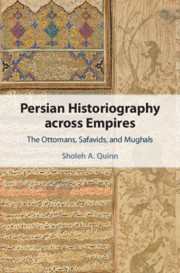Book contents
- Persian Historiography across Empires
- Persian Historiography across Empires
- Copyright page
- Dedication
- Contents
- Tables
- Acknowledgments
- 1 Introduction
- 2 Continuity and Transformation
- 3 Historiography and Historians on the Move
- 4 The First King of the World
- 5 Mirrors, Memorials, and Blended Genres
- 6 Conclusion
- Appendix The Chroniclers and the Chronicles
- Bibliography
- Index
3 - Historiography and Historians on the Move
The Significance of the Number Twelve
Published online by Cambridge University Press: 21 November 2020
- Persian Historiography across Empires
- Persian Historiography across Empires
- Copyright page
- Dedication
- Contents
- Tables
- Acknowledgments
- 1 Introduction
- 2 Continuity and Transformation
- 3 Historiography and Historians on the Move
- 4 The First King of the World
- 5 Mirrors, Memorials, and Blended Genres
- 6 Conclusion
- Appendix The Chroniclers and the Chronicles
- Bibliography
- Index
Summary
Chapter 3 shows how, in addition to drawing on earlier models, the chroniclers also looked to each other’s works as they composed their narratives.We see movement across dynasties in various ways, whether intellectually, as the chroniclers looked beyond dynastic borders to read and cite texts being produced in other parts of the Islamicate world, or physically, as chroniclers moved between Safavid, Mughal, and Ottoman territories, writing under different dynasties for different patrons.The chapter has as its centerpiece a case study focusing on one historian, Khvandamir. Drawing on a late Timurid history, Khvandamir wrote one of the earliest Safavid histories, his Habib al-siyar, and then moved to India, where he wrote one of the earliest Mughal narratives, the Qanun-i Humayuni.The analysis shows precisely how Khvandamir appropriated a portion of his Safavid era text dealing with the significance of the number twelve relative to the Shi‘i Imams, carefully transformed it into a “cosmological” text, and incorporated it into his Mughal history written for the emperor Humayun (1505-1556).The chapter ends with an overview of the fortunes of Mir Yahya Qazvini’s descendants, who left Safavid Iran for Mughal India.
Keywords
- Type
- Chapter
- Information
- Persian Historiography across EmpiresThe Ottomans, Safavids, and Mughals, pp. 73 - 106Publisher: Cambridge University PressPrint publication year: 2020

